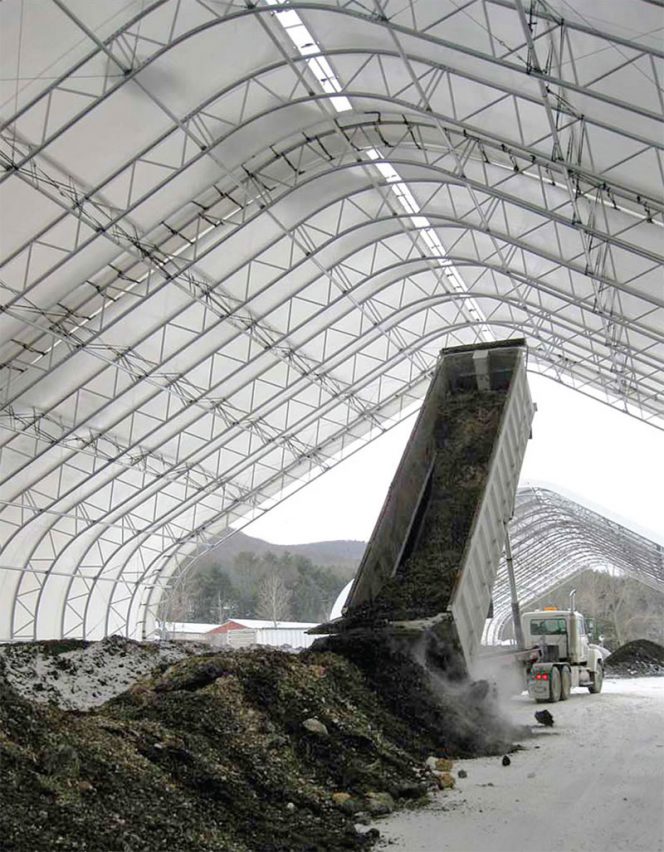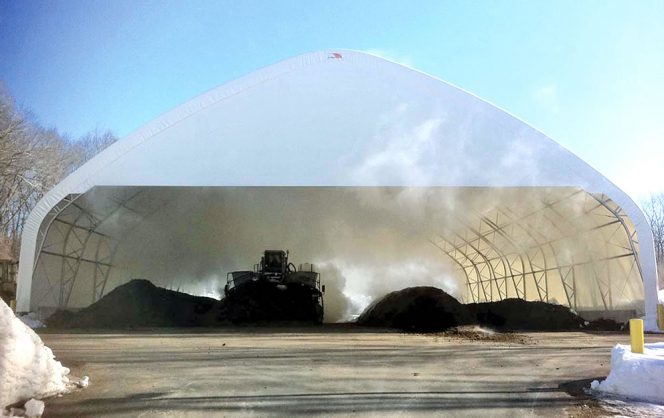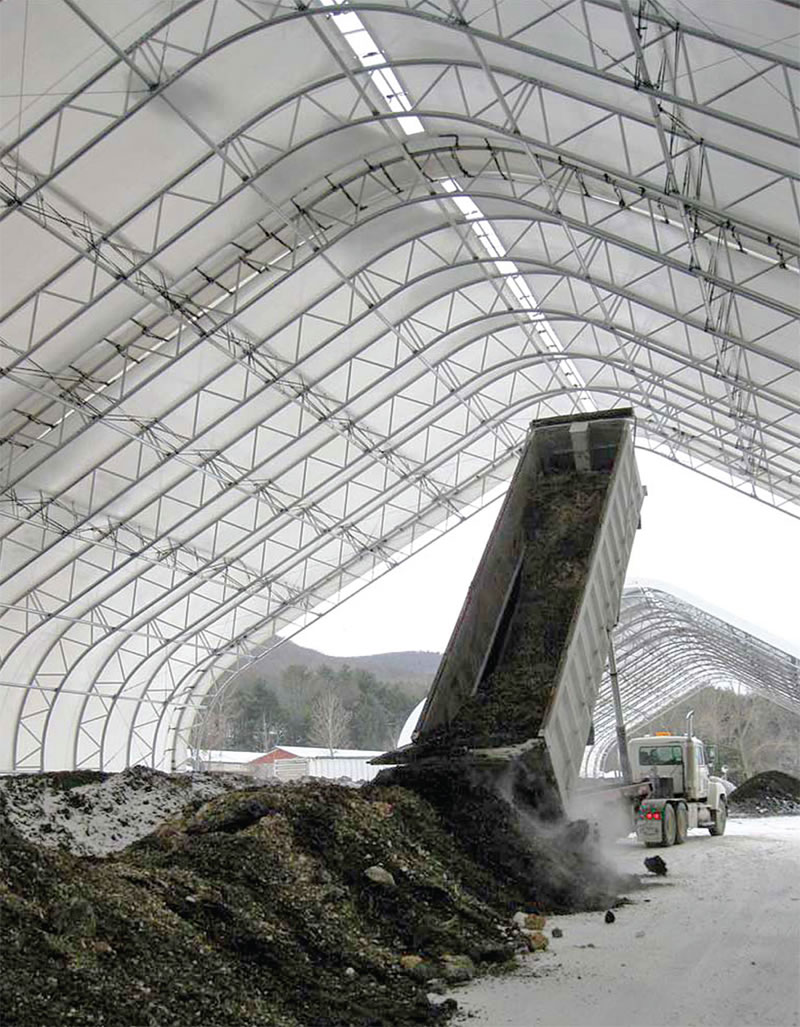Jessica Batchelor
BioCycle January 2019
Over the past decade or so, the prevalence of fabric structures at organics recycling facilities has steadily been increasing. To help the composting industry better understand why fabric structures have become so popular, BioCycle asked one of the leading fabric structure manufacturers to provide answers to some of the most frequently asked questions about fabric structures.

Depending on the manufacturer, fabric buildings provide a clean span design that is absent of support posts. This enables operators to arrange their composting facility for maximum efficiency. Photo courtesy of ClearSpan Fabric Structures
Q. It seems fabric structures have become more common than traditional buildings used for indoor composting. Why is this?
A. Fabric structures are typically lower in cost per square foot than a traditional building. And due to reduced construction timelines, installation costs are also much less. Some companies opt to build the structure themselves.
“There are a variety of foundation solutions to save on foundation and site work expenses,” notes Geoff Ching, Director of Sales at ClearSpan Fabric Structures. An example is ClearSpan’s Helical Anchoring System where the anchors are drilled directly into the ground, creating a secure and dependable foundation that can be used permanently or temporarily. “This style of foundation requires little site preparation, so users can nearly eliminate site excavation costs,” he adds.
Depending on the manufacturer, fabric buildings are also going to provide a clear span design that is absent of support posts. This enables managers to arrange their composting facility to maximize efficiency. Piles and rows can be placed anywhere within the structure, and with a large enough building space, vehicles and machinery can easily access compost piles.
Fabric structures also enable business owners to reduce monthly electricity needs as the covers allow natural light in, thereby reducing the need for artificial lighting inside the structures.
Q. What are the most common uses for structures at composting facilities?
A. Fabric structures can be used for anything from equipment storage to end product storage. However, active composting seems to be how most companies use a fabric structure. This is especially true in the agricultural sector. For example, the University of Connecticut (UCONN) has a large agricultural program, and it has been using a fabric structure to improve its waste management and composting for the past few years. Prior to the structure, the university was stockpiling manure near their agricultural lands or putting it in tanks near their barns. To better manage the waste, UCONN opted to construct a covered composting facility.
“We chose a fabric structure, because of the affordable cost and the ability for expansion,” explains Paul Ferri, the university’s environmental compliance analyst. UCONN has found the structure to be more effective than initially anticipated. It was built on an asphalt pad, so the facility could better manage moisture levels in the compost. Since the structure has been in use, UCONN hasn’t received any odor complaints.
The university also is composting more material than originally planned. At first, the idea was to process 25 percent of the farm waste, but about 40 percent is actually being processed. “The size of the structure can accommodate all equipment activity, including a windrow turner, payloaders and dump trucks,” he adds.
LHF Compost, Inc. in Peoria, Illinois, started its business by composting agricultural waste, but has since expanded to processing food waste as well. The company’s owner, Paul Rosenbohm, built a 100-foot wide by 465-foot long fabric building and has found success with the structure.
“We are able to fit four 14-foot by 450-foot rows of compost in the building,” explains Rosenbohm. “We have plenty of headroom, and the openness is ideal. We really like the strength of the metal frame and all of the natural light the cover lets in. Also, the ridge vent at the peak of the building lets the steam and vapor out.”
Q. Is it pretty common to fully enclose fabric structures at composting facilities? If so, what do you recommend in terms of doors?
A. With composting facilities, most users want the structure to have open-end walls to allow for maximum airflow, while still keeping the covered area dry. This helps a facility control moisture and anaerobic conditions, so odor levels can be minimized. In some cases, however, some compost manufacturers still want a completely enclosed facility. “If that’s the case, we can add ridge vents and tunnel ventilation in the forms of exhaust fans and louvers to help with air flow,” notes Mark Jamgochian, who designs composting buildings for ClearSpan Fabric Structures. “Doors can also be added for access. We can install roll-up doors anywhere on the structure.”
Steel roll-up doors are the go-to option for composting facilities. They provide the durability and security the facility is usually seeking. But for larger doorways, some manufacturers supply fabric doors, which allow for a maximum opening with a minimum cost. They tend to fold in on themselves within the threshold, to avoid taking up a lot of room. Fabric doors also can be motor operated, just like traditional doors.

The University of Connecticut’s agricultural program opted to construct a covered composting facility to better manage moisture levels in the windrows, and help contain odors. Photo courtesy of ClearSpan Fabric Structures
Q. Is any added protection of the structure necessary? And what are the general good housekeeping rules?
A. The required protection depends on the fabric building manufacturer. When considering this investment, facilities should opt for a building that features a galvanized steel frame, which provides the structural strength and the ability to withstand the corrosive environments found at composting facilities. The fabric covers should be able to hold up fine, but users should ask the manufacturer for case studies to ensure the cover’s longevity in a composting environment.
In terms of maintenance, one of the often-overlooked benefits of fabric structures is that little is required to keep them fully functional. Traditional structures have hard edges and corners that constantly collect dust and need to be cleaned. Most fabric buildings have rounded edges that minimize the dust and grime that collects. Also, since the frames are covered by a layer of fabric, there’s no place for pests to nest or hide, making pest management an easy proposition.
Every structure is going to require some sort of cleaning eventually. Users should hose it down and let it dry. The building’s natural ventilation allows the structure to quickly dry after cleaning, reducing the occurrence of mold and mildew.
Repairs may be required on the fabric if it tears, but this should be minimal or nonexistent. Rip-stop fabric covers are available that stop a tear in its tracks and allow it to be easily and effectively patched. Manufacturers offer excellent warranties, so look for one that’s offering at least 20 years on the fabric itself.
Jessica Batchelor is a content writer for ClearSpan, which specializes in fabric structures for the agriculture industry (www.clearspan.com).













